Hubard, William James (McKechnie Section 1)
Recorded by Jackson (The History of Silhouettes). The early part of Hubard's career is linked with the Hubard Gallery, which was founded in 1822 by Hubard's business manager, when Hubard was only thirteen, as a means of turning his precocious talent as a cutter to commercial account. In 1824 Hubard, after working in England and Scotland, travelled with the gallery from Ireland to the United States, and continued to work for it until March 1826, when he left it and thereafter worked independently. In the present entry I give an account of Hubard's career in England, Scotland, Ireland, the United States and Europe. The Hubard Gallery continued to flourish independently after Hubard's departure in March 1826, and I give an account of its activities from that date onwards in a separate entry.
Far more research into Hubard's life and career has been carried out in the United States than in Britain, and I have had access to much American material. The first matter to consider is the date of Hubard's birth.
It has been generally assumed that Hubard was born on 20 August 1807 at Warwick, as stated on the artist's tombstone in Richmond, Virginia. To complicate matters, the inscription on the tombstone gives his age at death as forty-five, whereas it is now known that when he died (in 1862) he was about fifty-two.
In January 1948 a detailed survey and exhibition of Hubard's life and work was presented at the Valentine Museum, Richmond, Virginia. A complete and thorough account of Hubard's life had been written by the former curator, Miss Helen McCormack. This account (on which I have drawn copiously when preparing the present account of Hubard's life and career) gives the date and place of birth mentioned above. On 10 February 1948, however, soon after the exhibition was opened, fresh evidence came to light. Descendants of Hubard, living in the United States, gave Mrs Ralph Catterall, then Curator of Prints and Manuscripts at the Valentine Museum, access to a letter from Horatio Hubard, brother of the artist, stating clearly that W. J. Hubard was born on 6 April 1809 in Whitchurch, Shropshire. The Vicar of the parish church, Whitchurch, could find no information in the church records, but the county archivist at Shrewsbury told me that the name of a family called Hubbard, or Hubbart, does appear in the printed registers of a Nonconformist Chapel in the neighbourhood of Whitchurch before 1812. The Reverend E. H. Nicholson, minister of Wem Methodist church, told me that these references must be either from the registers of the Congregational Church or of the Unitarian church in Whitchurch, both of which existed before 1812. (Unfortunately, all the early records of both the Congregational and Unitarian churches in Whitchurch. which had amalgamated in 1875, were destroyed by fire some years ago.)
The date and place of Hubard's birth, as stated on his tombstone, are not confirmed by any documents. and it seems reasonable to assume from the more recent evidence given above that Hubard was probably born on 6 April 1809 at Whitchurch. He is known to have been the son of William James and Jane Hubard
(or Hubbard) and to have had two younger brothers, Horatio and Edwin, who were both born in Hereford.
Hubard is reputed to have first acquired his facility as a profilist by cutting silhouettes of members of the congregation while he was in chapel. His professional career began when his talent was discovered and he started to cut silhouettes for the Hubard Gallery, which, as I have mentioned, was principally established to turn his gifts to commercial account. It appears, however, that a few other young profilists worked for the gallery after it arrived in New York. The gallery was presumably founded by the 'Mr Smith' who is known to have been Hubard's manager, and who may have continued to manage the Hubard Gallery even after Hubard himself had ceased to work for it. The precise identity of Smith remains unknown. It has been suggested that he was Edward Tyrell Smith, son of an admiral, who began his career as a 'Redbreast', or Bow Street runner, and eventually became a showman and ran Cremorne Gardens, Drury Lane, among other theatrical shows. This Smith, born in 1800, was therefore only nine years older than Hubard. The traditional assumption that Hubard's manager exaggerated his protege's youth in order to stimulate interest in his work is now known to be probably unfounded.
It was in Ramsgate in September 1822, when he was thirteen, that Hubard was launched on his career. This is known from a catalogue of subjects taken at the Hubard Gallery, published in a second edition in New York in 1825. This contained a 'little Memoir of Master Hubard', written by a Mr Northouse, a previous editor of the London Magazine and also of the Glasgow Free Press. The catalogue was owned (in 1929) by the Massachusetts Historical Society, according to an article by Mabel M. Swan in Antiques June 1929).
The Duchess of Kent and her three children were staying in Ramsgate at the time, at Townly House, the seat of Lady Townly. Hubard cut profiles of the Duchess, Princess Victoria, and the Princess's halfbrother and sister: Prince Charles and Princess Feodore. (In the catalogue referred to above, these profiles were listed as No. 73)
The gallery was in England for the last three months of 1822 and all of 1823, and left for Scotland during January 1824. Young Hubard thus worked in England for only fifteen months. It is not surprising, ,therefore, that although his output was enormous during this period, only a small proportion of the work produced by the gallery in England was from the hand of Hubard himself.
I quote below (from Jackson's Dictionary) advertisements issued by the gallery, stated by Jackson to have appeared in a Norwich newspaper (she does not give its name) in January 1823:
Extraordinary development of juvenile Genius.
Just arrived at Mr. Critchfield's, Cutter, Market Place Norwich. Master Hubard, the celebrated little artist, who, by a mere glance at the face! and with a pair of common scissors! not by the help of a Machine, nor from any Sketch with Pencil, Pen or Crayon, but from Sight alone!!! Cuts out the most spirited and Striking Likenesses in One Minute — Horses. Dogs, Carriages, in short every Object in Nature and Art are the almost instantaneous productions of His Talismanic Scissors
Likenesses in Bust, Is. Two, Is. 6d.
Young children Is. 6d. Two 2s.
Full length 5s. Two 7s. 6d.
Families attended at their own houses: terms extra, if less than seven in number.
Master H. may be seen from 11 in the Morning until 4 and from 6 until 9 in the evening.
An editorial comment was published in the same issue:
We cannot avoid expressing our gratification at the continued success which seems to attend that interesting little artist Master Hubard, whose astonishing abilities, persons of all classes seem to be eager to put to the test. We do not hesitate to pronounce Master H. the greatest phenomenon of art that this city ever witnessed, and we look forward with confidence to the time when his talent will display itself as conspicuously in the use of the pencil as it now does in the use of the scissors.
The following announcement appeared in the same newspaper on 6 February:
Master Hubard's stay in Norwich is prolonged until Wednesday next. Those who are desirous to witness his wonderful Delineations, and at the same time to obtain correct Likenesses of themselves, or any favourite animal, are requested to call at Mr. Critchfield's, Market Place. Norwich, between the hours of Ten and Four before Wednesday, 12th. inst., which will positively be the Last Day of his stay in Norwich.
A previous advertisement (29 December 1822) in a Newmarket newspaper had been similarly worded. with the addition of the phrase, 'Likenesses faithfully copied. Frames in great Variety.'
The Hubard Gallery's itinerary in England (with Hubard himself in attendance as silhouette cutter) can partly be gathered from advertisements, handbills and other sources (some quoted above, some others illustrated):
13 September 1822 Ramsgate
2 December 1822 Cambridge (On this date Horatio Hubard sent a letter to his brother addressed: 'Master Hubard, Mr Smith, Opposite the King's Head, Sidney Street, Cambridge.)
29 December 1822 Newmarket (see handbill used in Cambridge)
January 1823 Norwich
12 February 1823 Departure from Norwich
15 May 1823 Stamford (see handbill used in Wakefield)
Soon afterwards Wakefield (see handbill) Bury (see handbill)
4 September 1823 Liverpool (On this date Hubard's mother sent a letter addressed to him at the Post Office in this city. Another
address was 'Liverpool Stoakes Rooms, Church St., Liverpool'; see advertisement quoted below.)
The gallery is also known to have visited Manchester, and probably visited Sheffield between September and December 1823. A handbill shows a silhouette by Hubard, obviously taken in the 1820s, of one 'Mappen. Bill-Poster', of Sheffield; it is illustrated in the entry on the Hubard Gallery, since it contains a reference to 'American Views' and therefore must have been used after the return of the gallery from the United States to England. This handbill bears an address at 109 Strand, London. There is another handbill (in the National Portrait Gallery) which also shows a profile taken by Hubard, was dated 1832, used after the gallery came to England from the United States, and bears the same London address. The subject of the profile is a match vendor in Bristol named Luke Hardwell, and 'American Views' are mentioned. We can deduce from it that Hubard spent some time in Bristol while he was working for the gallery in Britain.
When the gallery arrived in Liverpool late in 1823 the following advertisement (discovered by Coke) appeared in the local press:
JUST ARRIVED AT STOAKE'S ROOMS, CHURCH STREET, MASTER HUBARD,
Without the aid of drawing or Machine, but merely by a slight glance at the face, produces, in less than 20 seconds, the most strikingly-correct and spirited Likenesses with a pair of common scissors. His exhibition of fancy Cuttings consists of Flowers, Trees, Landscapes, Animals, Likenesses of distinguished individuals, Family Groups, Sporting Pieces, Caricatures, &c. Admission One Shilling, which entitles the visitor to one likeness in bust: two of the same person, 1/6d. Whole length Likenesses 5/-; two 7/6d. Likenesses taken on Horseback, or in open Carriages. Portraits of Horses, Dogs, &c, &c. The figures may be had plain or elegantly Bronzed.
The gallery probably left Liverpool for Scotland after Christmas 1823. By 24 February 1824 it was in Glasgow, where it achieved great success. On that date the Glasgow Philosophical Society presented Hubard with a silver palette (now in the Valentine Museum). Presumably Hubard and the gallery had been in Glasgow for several weeks by this date.
485
On I April an admirer of Hubard's art (John Baird, of Edinburgh, wrote a letter to Hubard addressed to 'Master Hubard of the Exhibition, Princes Street, Edinburgh'. The gallery, then, was certainly in Edinburgh in April, and had perhaps been in that city since March. We know that by 2 May it was in Dublin, for on that date Hubard's father wrote a letter to him addressed to 'Master W. J. Hubard, Junr. Picture Gallery, No. 45, Sackville Street, Dublin'. (It seems, incidentally, that at no time during this period of travel in Great Britain did the young artist rejoin his family.)
From Ireland the party set sail for the United States. They arrived in New York in August, within a few days of the arrival in the city of General Lafayette. One of the first profiles which Hubard cut in the United States was of the general.
Career in the United States
On 1 October 1824 Mr Smith's wife wrote to her mother, mentioning that the gallery had arrived in New York and that her husband had had to pay more than £30 in duty on a collection of over one hundred cuttings which he had taken with him for a preliminary exhibition. Mrs Smith mentions two other boys, besides Hubard, who were with the gallery, referring to them by their Christian names, Emmanuel and Robert. (Neither of them was 'Master' Hankes, whose names did not include Emmanuel or Robert: see Hanks (Hankes), Jarvis (or Jervis) F.)
The gallery remained in New York until 14 October 1825. A month later an advertisement appeared in a Boston newspaper, the Columbian Sentinel, in which the Hubard 'Gallery of Cuttings' was publicized. It was described as the 'Papyrotomia', and its attractions were said to include a Panharmonicon, claimed to be a wonderful mechanism that played as many as 206 musical instruments at the same time. Advertisements in which Hubard's connection with the gallery is implied continued to appear in the Boston Press until 29 March 1826. After this date, this connection appears to have ceased.
We know from trade labels that the Hubard Gallery spent some time in Canada, possibly from some time in 1826 until January 1828, during which period there is no record of it being elsewhere. But it is evident that Hubard himself could not have been with the gallery in Canada (if it was there) throughout this time, for in May 1827 a portrait of him, painted by an artist named Hill, was shown at the first loan exhibition held at the Boston Athenaeum. The exhibition catalogue also lists (No. 319) a portrait by Hubard of John Doggett, Junr: Hubard's first important work as a painter in oils. It is said by members of the Doggett family that this portrait was painted in the studio of Gilbert Stuart, and since, later in life, Hubard mentioned that he had been acquainted with this well known artist, it is probable that he had been a pupil of Stuart during the early months of 1827. We know from a letter from John Doggett's company to one John B. Pendleton, dated 4 January 1828, that Hubard was in New York at this time. On 4 May 1829 his mother addressed a letter to him in Philadelphia. John Sartain. the engraver, states in his Reminiscences of a very Old Man that Hubard painted a full-length portrait of President Andrew Jackson in that city, and that Sartain engraved a plate after this portrait in 1832. Thereafter, Hubard became an established painter in the United States.
In her catalogue of the exhibition at the Valentine Museum in 1948 Miss McCormack divided Hubard's work into an early period (before 1838), a middle period (1838-47) and a late period (1848-62). In 1829 the artist was for a short time in Philadelphia, where he painted a small seated portrait of President Andrew Jackson; in 1831 he was in Baltimore, where his address was given in the directory of that year as the 'Athenaeum'. In 1948 at least twenty-eight portraits in oil by Hubard were shown in Baltimore. These were of cabinet size, and most of them measured about 7 x 7 in. or about 20 x 14 in. Several have carefully painted backgrounds, with good detail added, trees, mountains and streams being particular features. One of these early portraits (that of John Caldwell Calhoun, Vice-President of the United States, 1831-32) is illustrated.
471
Other sitters included John Marshall (1755-1835), Chief Justice of the United States; members of the Tabb family (into which Hubard was later to marry); Henry Clay (1777-1852), Senator from Kentucky; and other well known contemporary figures.
In c. 1833 Hubard moved to Virginia. He had already visited the state, professionally, more than once; he had travelled, for instance, up the James River, making stops for commissions at some of the large houses en route. By the spring of 1836 Hubard was moving in the state between Richmond, Gloucester, and Norfolk. Gloucester appears to have been his main place of residence, and there he went so far as to buy himself a house, a 'frame dwelling', known as the 'Retreat', which stood opposite the old Ordinary, near Gloucester Court House. In the 1830s Gloucester County was a country region in which the arts of life were practised according to Virginian standards. Isolation by water on three sides made the county socially self-sufficient, and many families had intermarried. A painter, coming into such a society, could not fail to be well received, and Hubard possessed social gifts as well as talent. His letters (excerpts from which are quoted below) show him to have been an entertaining and amusing companion. It was not surprising that his courtship of Miss Maria Mason Tabb, in 1837, met with a response on her part.
Maria, who had lost both her parents, was living with her brother George at Toddsbury, one of the oldest seats on the North River. Her uncles, all well established in Gloucester and well known in the state, were John Tabb of White Marsh, Henry Wythe Tabb of Auburn, Philip Edward Tabb of Waverley, and William Patterson Smith of Glen Roy.
Hubard and Maria first entered into a secret engagement. Soon after this Hubard wrote to Maria: 'I have always found myself more pleasantly situated when I have been estimated as a woman hater, or, more correctly, as an enemy of matrimony. Because people less fear my intercourse with their daughters, &c. Few would wish a child to marry a poor unknown, and I am too sensible of this fact to place myself in a situation to wound the most vulnerable of my feelings. Their quantum of pride is but a drop in the ocean to mine. My misfortunes have made me painfully morbid, and if I could be driven to derangement, I should be mad upon that theme.' It seems that Maria's brother and uncles disapproved of Hubard's background and, presumably, of his previous connection with a travelling showman. This opposition appears to have forced Hubard to leave Gloucester, and to go to Edenton, then to Norfolk, and finally Baltimore in an attempt to build up his financial resources with a view to making his suit more acceptable to Maria's relations. One uncle (Maria's mother's brother, Patterson Smith) presumably knew nothing of the engagement, since he travelled with the artist. At this time Hubard's letters to Maria were sent through a friend, James K. Dabney. Those sent from Baltimore refer to only one commission, and it is doubtful that the expedition was a financial success. Part of one of these letters, bearing Hubard's signature, was written on 30 April 1837, when Hubard was about twenty-eight.
486
After dwelling despondently on his own imperfections. Hubard refers to a rival: 'tell me, my dear M, that he is gone'. In spite of the paucity of his commissions, he finishes by saying, 'I know but little of what I write, so totally overcome am I by the day's exertions. The sum is tho' to be assured that he is not your idol. Ever, yours, Hubard.'
The expedition later became more successful, and Hubard raised enough money for the two projects which he had in mind: the first of these was, of course, to marry Maria Tabb; the second, to travel in Europe. It is also possible that, by the end of this year. Maria may have inherited some money from her parents' estate. At all events. Hubard and Maria were married, probably during the autumn of 1837
Travels in Europe
By 21 January 1838 the couple were in Paris, where they established themselves in reasonable comfort.
On this date Hubard wrote an interesting letter to his friend Josiah L. Deans, of Gloucester, Virginia. (The original is in the Valentine Museum.) Hubard begins his letter with the words, 'I have just arrived as safe as a chicken out of an egg shell, and send this to hope you are shelling out too . . Hubard gives an amusing description of his reactions to the beauties of Paris. In particular, he draws attention to the many statues in the city:
487, 488
It is glorious to see upon what a stupendous scale stone and mortar can be heaped together. The palaces are grand, the gardens more so but one is most singularly annoy'd to see rows of folks standing in the cold in a state of nudity. The young cheek crimsons: & the old matron fans herself, while the men cry beautiful. I wonder why they make all the statues naked. A sculptor's tailoring can't be very dear, and it would add very much to one's comfort to go in the parks on a frosty day, and see all the effigies covered up, tho' I believe the classics unmask everything.' Hubard includes a sketch in the letter, preceded by the following passage: 'You will see crowds attracted by the simple circumstance of one foolish fellow seeing something he does not understand. For instance at the school I draw, I picked up a piece of paper on which a boy had scrawled some shapeless figures. I put it in a conspicuous place, and the whole squad were around it in silence and perfect gravity. I'll give you a scratch or two of the unmeaning faces and expressions an abominable and pointless point will cause. Just imagine yourself a caricature and a little boy first stops to look at you.' The letter ends: 'Now as regards living I use some little care, for instance most of your dinners do not cost for Maria myself and her maid more than 50 cents. I keep most all the little articles of grocery in the house. Here ends the book. Give our loves to your wife. I start in a few minutes for England — to return in a week. They travel quickly here. Yours truly, W. J. Hubard.'
At some stage of the Hubards' sojourn in Europe Maria gave birth to a child and we know that, having returned to France (presumably after their brief visit to England), they travelled with the baby from Geneva to Florence via Milan.
While he was in Paris Hubard painted a portrait of his wife and a landscape, Smugglers on the Seine; he also copied a portrait by Rembrandt in the Louvre. He also painted portraits, and copied others, while in Florence.
Later Career in the United States
The Hubards seem to have stayed in Europe until the summer of 1841. By 19 October they had returned to the United States: on that date an advertisement appeared in the Richmond Whig, in which Hubard offered his services as a portrait painter. He took rooms in Main Street, Richmond, and this was to be his centre for the rest of his painting career. For a time, his family home was a country house in Gloucester, but the upkeep of two establishments proved too difficult for the unbusinesslike Hubard, and in the late 1840s he moved his family to Richmond. The child who had been born to the Hubards in Europe had died, but by the time of the move there were two more, William James and Ella Gordon. Hubard painted two charming water-colour portraits of these children in the early 1850s.
477
Although the family were still based on Richmond, Hubard and his wife visited Philadelphia and New York in 1844 and 1846 respectively. His pessimism of the 1830s was now over, and by the end of the 1840s he had become known as a successful painter. During this period he painted the imaginative Dream of Columbus and The Milkman and the Maid.
473, 474
Eminent American citizens admired his work. Longfellow included some of his drawings, illustrating his poems, in a publication in 1851; Edward T. Peticolas, a highly regarded Richmond artist, sat to him; Mann Satterwhite Valentine II, founder of the Valentine Museum, sat to him in c. 1851, and Philip St George Cocke, while presenting portraits to the Virginia Military Institute in 1853, described him as one of America's leading artists.
475
Prosperous planters of Gloucester, who built country houses during the early 1850s, often named them after places romanticized by Scott and employed Hubard to paint for them pictures representing Amy Robsart, Diana Vernon, or Effie Deans. Many of these paintings were of considerable merit.
A friend of long standing, Dr William Talioferro Junior, pressed Hubard to return to England for the Great Exhibition of 1851 at the Crystal Palace and there paint a portrait of Queen Victoria with which to impress his American clientele; but Hubard declined the suggestion. He remained in Richmond, and in 1852 issued a prospectus for drawing and and painting classes. The second page of this two-page prospectus, quoted below, gives an impression of Hubard's ambitions as a drawing master:
If any branch of education is to be neglected, either of the above and even others would be less missed, for the necessary process to initiate a pupil in drawing &c., would open the avenue to the whole field of practical and Philosophical Science. It may justly be concluded, that from the Professional man to the Mechanic, the rudimental branches of Drawing are not only useful, but strictly essential. As Drawing is now taught, the result is worse than the loss of time and money. The only satisfaction obtained is, that a parent can exhibit a stiff Landscape or a harshly lined crayon Drawing by an accomplished daughter, or a Prodigy of a Son, and the innocent pupil is often made to blush at the fulsome praise bestowed upon the effigy specimen of Art knowing that the Teacher regulated and put into a finished shape the expressionless daub, incapacity had been forced to perpetrate. It only requires a moment's reflection to understand the truth of the above, and the necessity of either embracing a more satisfactory means of acquiring the accomplishment, or of abandoning the pretention. and thereby save the parent or scholar front the most abject vanity, that of flattered ignorance. The undersigned has been maturing a work upon rudimental Art, and wishes to test practically his theories before he brings it before the world. it being both a costly and laborious enterprise. He therefore proposes to give three series of lessons, each series to form a distinct class, of twenty-four lessons. The first series or twenty-four lessons, twenty dollars; the second, twenty five dollars. and the third, thirty dollars. The whole occupying nine months or three quarters, making the lessons two a week. It would be ridiculous to assert, that a pupil at the expiration of this time would be an Artist, depending, as of course it would, upon the natural fitness of the scholars' mind to receive an Artistic education, or his capacity for Mechanical execution. Nevertheless, he is obliged to be intelligent upon the subject, and capable of sketching or drawing what he sees or describes, if not in a masterly manner, certainly in a comprehensive one. The initiatory ground will be entirely gone over, so that according to the abilities and industry of the Scholar, he will be enabled to attain the higher branches with very little further assistance. The undersigned does not bind himself to pursue this project farther than the completion of the three series, having no intention to become a Teacher beyond the object he has in view; he therefore, will not detain pupils in the lower classes if their progress fits them for the more advanced, but will pass them up, and even urge them to the more intricate and professional points, which will enable them more successfully to go alone.
Male and Female Classes will be distinct. Children and grown persons will be separated. The number will be limited, as the undersigned can only appropriate a portion of the day to such a pursuit. The undersigned will have an afternoon and night class. This will be arranged to suit the convenience of the pupil, for it will be absolutely necessary, that the Scholar should neither be fatigued before he takes his lesson, nor be hurried into another pursuit immediately after the lesson is over, as practice is absolutely necessary, which the pupil can pursue either at the rooms of the undersigned, or at their own homes.
Ladies can form their own Classes of ten or twelve if they wish, but it is important the undersigned should have them made up before the fifth of October, and as much earlier as possible. having limited his number. No Class can be taken when the amount is complete.
The undersigned requests all persons who wish to enter as pupils, to make application at once, either to the rooms of the undersigned, over Valentine & Crenshaw, Broad Street, or through the Post Office, naming whether the person be grown, or, if not, to state the age.
TERMS
First Series of 24 Lessons $20.00
Second do. do. do. 25.00
Third do. do. do. 30.00
MATERIALS extra, which the pupil can furnish or obtain from the undersigned. Fees to be paid in advance. Notice will be given to each applicant of the day on which the Classes are opened.
RICHMOND, Sept. 16th, 1852, W. J. HUBARD
Since his years in Florence, Hubard had been interested in sculpture and he now turned his attention to the statue of George Washington, by Jean-Antoine Houdon, in the Virginia state capital. Thomas Jefferson, who held under Washington offices which included the post of Minister to France, persuaded the French sculptor to cross the Atlantic in 1785 and execute this marble statue of Washington, which eventually he signed and dated 1788. In 1796 the statue was set up in Richmond, where it still stands today.
On 17 September 1853 Hubard published a statement that he had been given exclusive rights to reproduce copies of the statue for seven years. The task of making cast bronze reproductions of the statue occupied Hubard, and made inroads on his money, from 1853 until 1860. In c. 1854, or a little later, Hubard acquired the house of a friend who had died and converted it into a brass foundry. He called on friends to assist him financially in this enterprise, which had come to be of the utmost importance to him. His principal benefactor was Joseph Allen, Clerk of the Supreme Court of Virginia and the owner of extensive property in Richmond. After some disappointments, success was at last achieved on 23 February 1856, and the first perfect bronze copy of the statue was dedicated at the Virginia Military Institute on 4 July 1856 by Governor Henry G. Wise. In February 1857 the North Carolina General Assembly authorized the purchase of a second copy, and in the following year South Carolina authorized the purchase of a third for the State House which was then under construction in Columbia. After this initial success, however, other states did not show any interest in the enterprise. Of the remaining copies, one, sold after Hubard's death, is now in the Metropolitan Museum of Art, New York, and another is at Miami University, Oxford, Ohio.
Throughout the years 1853-60 Hubard continued to receive commissions for portraits; his paintings and drawings were exhibited at the Richmond Athenaeum and at the Mechanics Institute, and in C. 1857 he painted a fine portrait of Washington, based on Houdon's statue.
478
In 1861 the Civil War broke out. On the secession of Virginia from the Union in April. Hubard found himself a citizen in a state where patriotism had new idols, and statues of Washington were no longer of prime importance. By the autumn, Hubard was producing cannon in his foundry for both state and Confederate governments. As early as 1856 he had expressed an interest in gunpowder: a letter written by his daughter, Mrs John J. Lloyd, refers to 'Father's powder compound invention'. In March 1861 Hubard had visited Charleston to obtain the interest of the ordnance officers of South Carolina both in a new type of rifle and in a 'chemical compound'. It is to be supposed that from the casting of guns in his foundry to the making of explosives, in which he had expressed an interest some years earlier, was a natural step. It was also to prove a fatal one, for on 13 February 1862 a bomb exploded at his foundry while he was present, and two days later he died from his injuries.
Hubard's death was reported in the Richmond Whig and Advertiser and in the Richmond Despatch. The announcement in the latter newspaper (Monday 17 February 1862) reads as follows: 'Died, at his residence near this city, on Saturday night, 15th inst. Wm. J. Hubard, Esq. His funeral will take place from St. James' Church today, at 12 o'clock. The friends of the family are most respectfully invited to attend.' An obituary appeared in the same issue:
We regret to announce the death this morning of Wm. J. Hubard, Esq., the artist, which was produced by the injuries received by him at his foundry in Sidney, on Thursday, by the explosion of a bomb. One of his limbs and the fingers of one hand were so severely injured as to require amputation; the shock to his constitution proved too great for human endurance, and the victim of the unfortunate affair, after suffering untold agony until 9 o'clock on Saturday night, breathed his last. Mr. Hubard was an Englishman by birth, and aged 45 years. He was regarded as one of the most gifted artists who had lived in the South for many years. He was connected by marriage with an old Virginia family. His bronze duplicates of Houdon's statue of Washington are well known to the country. At the breaking out of the present war, he turned his foundry into a government cannon factory, and was engaged in making projectiles when he received the wound that caused his death. He was a good citizen, and a gentleman of varied accomplishments, and his death will be regretted by many friends.
The erroneous reference to Hubard's age as '45 years' was repeated on his tombstone. He was buried in the Hollywood Cemetery, Richmond.
Hubard's Work as Silhouette Artist
Though I have illustrated examples of Hubard's work as a painter in the United States, I shall only discuss here his style as a cutter of silhouettes while he was working under the management of Mr Smith in the early days of the Hubard Gallery.
Many full-length profiles inscribed as Hubard's work have been illustrated by previous writers. To judge from their appearance, however, some of these were produced by the gallery after Hubard was no longer working under its aegis. The illustrated profile of 'Master Cave' on his pony 'Flag', however, shows a boy wearing the small frill collar, showing above the jacket, which was going out of fashion by the mid-1820s, and it would appear, therefore, that this is one of the silhouettes which Hubard cut himself. I have illustrated several other examples. In The Art of Silhouette, Coke illustrates a fine example of 'genre' cutting by Hubard (opposite page 222). This looks like some of the work done in this field by Barbara Anne Townshend (q.v.).
Hubard probably cut his likenesses from white paper, afterwards rubbed with a blacking of some type, secured by fixative. At least two of his bust-length profiles (including the profile of 'Master Cave') are embellished with gold, but whether Hubard himself carried out the touching with gold paint is difficult to say. As I have mentioned, by the time the gallery was in New York two other boys (Emmanuel and Robert) were working for it, and they may have embellished silhouettes which Hubard had cut.
The illustrated bust-length profiles show differing bust-line finishes. Another feature is the lack of attention paid to the eyelash, which is often absent altogether.
According to the gallery's advertisements, many illustrations for stories, landscapes, and other fanciful subjects were cut. One of these, listed in one of the gallery's catalogues, was a View of Epsom Races which contained as many as three hundred figures. Hubard was a fine freehand cutter of game and animal subjects, and far more versatile than the illustrations of his portrait profiles suggest.
Trade Labels
Three trade labels are known to have been used by the Hubard Gallery during its early period in Britain, and silhouettes by Hubard which bear them have survived.
479-481
Trade Label No. 1 is handwritten, possibly by Smith; it may have been used after supplies of printed labels had been exhausted. The illustrated example (which has been trimmed) reads:
Cut with Scissors by Masr. Hubard [wi]thout Drawing or Ma[chineJ
Trade Label No. 2 was probably in use by the end of 1822, and was certainly in use by January 1823. It gives the artist's age as thirteen, although he must have been fourteen by the time the label was in use.
Trade Label No. 3, probably in use by the end of 1823, has most often been seen on the reverse of silhouettes cut by Hubard in Britain, but while Hubard was still with the gallery in New York, a stamp or stencil (worded similarly to Trade Label No. 3, but not giving the artist's age) appears to have been used by the gallery. While the gallery was in Boston, another stamp or stencil was used; this read: 'Cut with scissors by Master Hubard, without Drawing or Machine, at the Gallery of Cuttings and Panharmonicon Concert Room.'
Trade Labels used by the Hubard Gallery after Hubard had left it are considered in the entry on the gallery, but are numbered in continuing sequence after the labels discussed here. All labels which mention the silver palette presented to Hubard are now considered to have been used by the gallery long after Hubard had left it, and these too are discussed in the entry on the gallery. This also applies to labels bearing embossed 'Hubard Gallery' stamps, since they cνere used in the 1830s and 1840s.
Several handbills advertising Hubard's talents are illustrated: they have been referred to above.
482, 484
Ills. 466-488
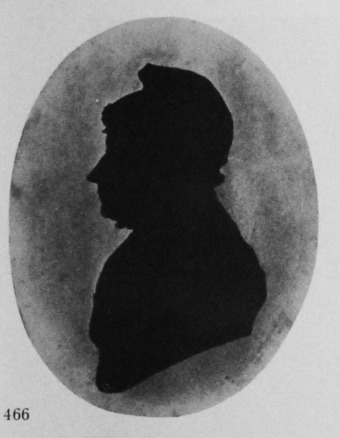
Mrs Mary Marriner
Cut silhouette
c. 1822-23
3 3/8 x 2½in./86 x 64mm.
Trade Label No. 1
Frame: oval, turned pearwood
The inscription states that the sitter was the wife of John Marriner (see 704 and 1460), was baptized at Quarry Moor on 15 March 1728, died on 7 January 1807 and was buried at Ingleton. Her father was Richard Causon of Quarry Moor. This silhouette must therefore be a copy by HUbard of an earlier silhouette by another artist.
Author’s collection
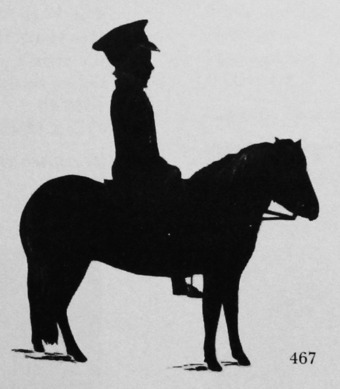
‘Master Cave’ on his Pony ‘Flag’
Cut silhouette, embellished with gold
c. 1822-23
From the collection of the late J. C. Woodiwiss
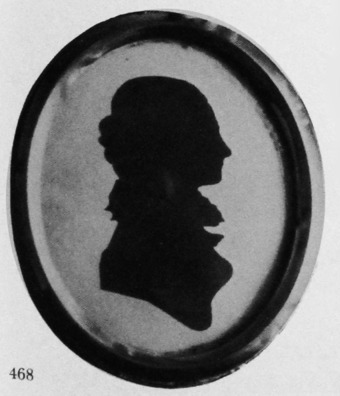
Miss Mary Anne Wiseman
Cut silhouette, bronzed
1823
Trade Label No. 2
Frame: papier mâché
Graham Robinson collection
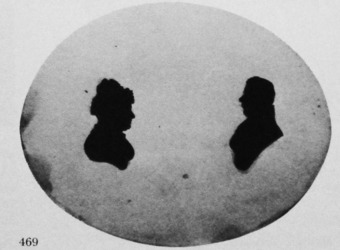
Mr and Mrs Hughes
Cut silhouettes
c. 1823
Height of each figure: 1in./29mm.; size of oval: 2¼ x 3½in./58 x 90mm.
Trade Label No. 2
Frame: papier mâché
Author’s collection

Unknown woman
Cut silhouette
c. 1823
3½ x 2 3/8 in./90 x 61mm.
Trade Label No. 3
Frame: black reeded wood, decorated with brass rosettes at the corners
Author’s collection
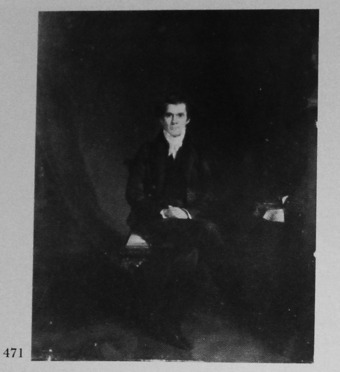
John Caldwell Calhoun
Oil on wood panel
c. 1832
20 x 14½in./508 x 369mm.
John Caldwell Calhoun (1782-1850) was Vice-President of the United States, 1831-32.
Corcoran Gallery of Art, Washington D.C.
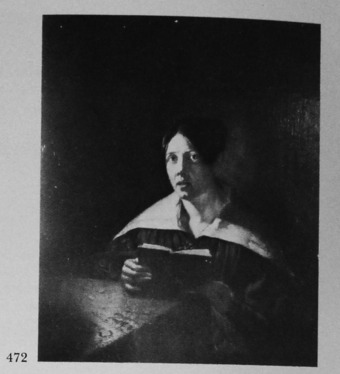
Mrs Maria Hubard (née Mason Tabb), the artist’s wife
Oil on canvas
1838-40
17 7/8 x 12¾in./455 x 324mm.
By courtesy of Mrs N. Walter Hubard
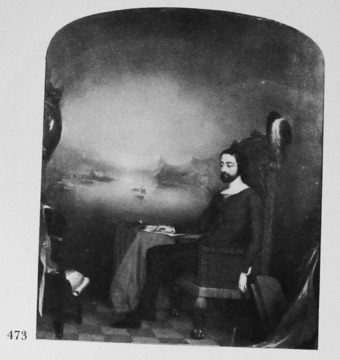
The Dream of Columbus
Oil on canvas
1838-47
30 x 25in./762 x 636mm.
Valentine Museum, Richmond, Virginia
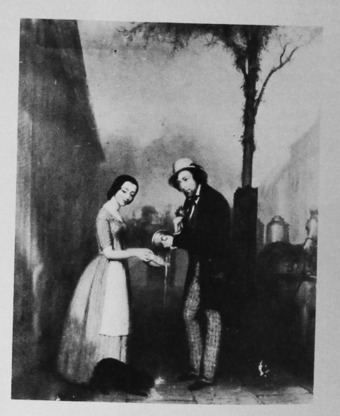
The Milkman and the Maid
Oil on canvas
1838-47
30 x 25in./762 x 636mm.
Valentine Museum, Richmond, Virginia
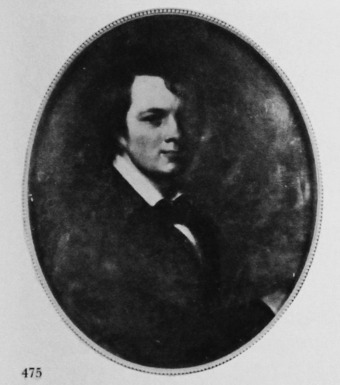
Mann Satterthwaite Valentine II
Oil on canvas
c. 1851
30 x 25in./762 x 636mm.
The sitter was the founder of the Valentine Museum, Richmond, Virginia.
Valentine Museum, Richmond, Virginia
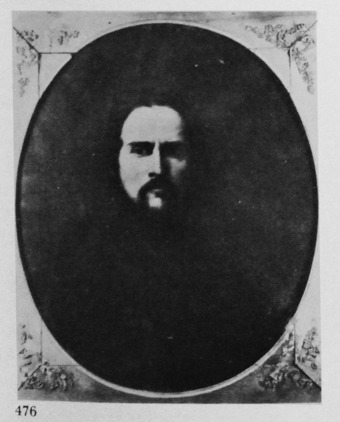
Portrait of the artist
Oil on canvas
c. 1852
30 x 25in./762 x 636mm.
In the possession of Mrs N. Walter Hubard
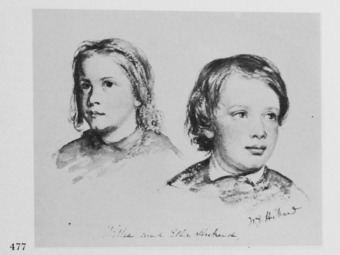
Willie and Ell Hubard, the artist’s children
Water-colour drawing
c. 1850-52
Valentine Museum, Richmond, Virginia
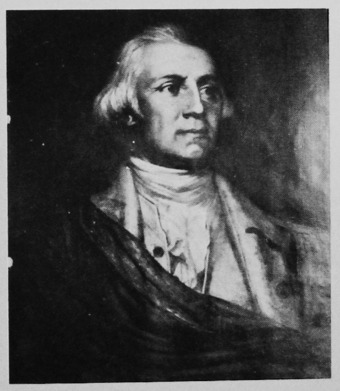
George Washington
Oil on canvas
c. 1857
36 x 29in./915 x 737mm.
Hubard based this portrait on the statue by Jean-Antoine Houdon in the Virginia State Chapel, of which he cast copies in bronze.
Valentine Museum, Richmond, Virginia
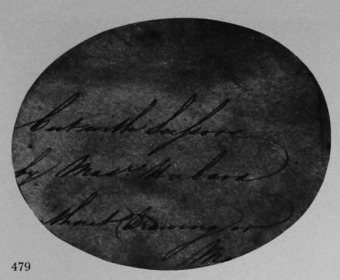
Trade Label No. 1 of the Hubard Gallery, used while W. J. Hubard was working for this concern. From the reverse of the silhouette illustrated in 466.
Author’s collection
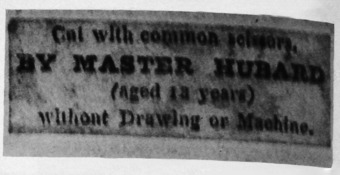
Trade Label No. 2 of the Hubard Gallery, used while W. J. Hubard was working for this concern.
Author’s collection
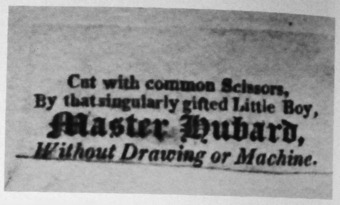
Trade Label No. 3 of the Hubard Gallery, used while W. J. Hubard was working for this concern.
Author’s collection
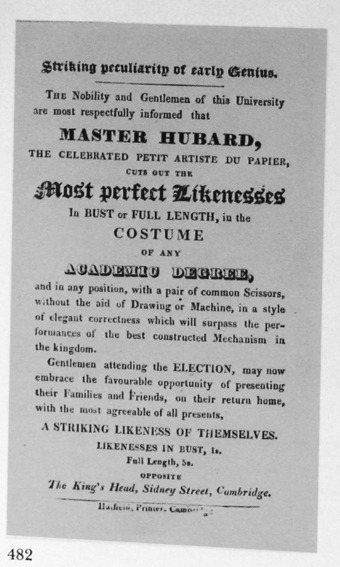
Handbill of the Hubard Gallery, advertising W. J. Hubard’s services, used at Cambridge in December 1822.
Bodleian Library, John Johnson collection
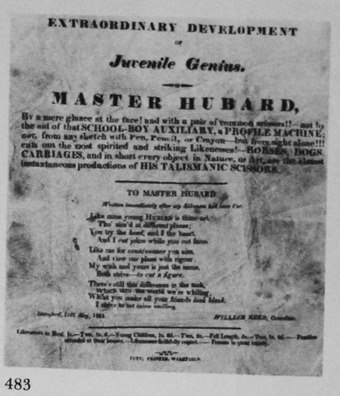
Handbill of the Hubard Gallery, used in Wakefield in 1823 to advertise the arrival of W. J. Hubard in the town. It contains the text of a poem written by a comedian from Stamford on 15 May, after Hubard had cut his silhouette.
R. Kilner collection
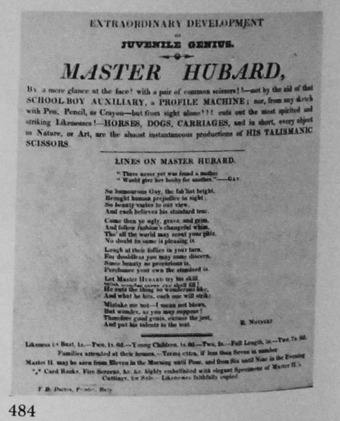
Handbill of the Hubard Gallery, advertising W. J. Hubard’s services, printed at Bury and used during 1823 (not long after 15 May). It contains the text of poem by ‘E. Notserp’ (presumably a thin guise of anonymity for one E. Preston).
D. S. Patton collection
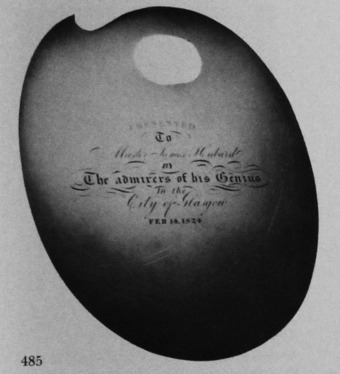
The silver palette presented to W. J. Hubard by the Glasgow Philosophical Society on 14 February 1824.
Valentine Museum, Richmond, Virginia
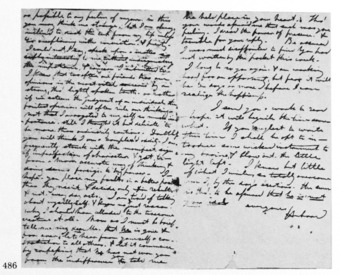
Letter written by W. J. Hubard to Maria Mason Tabb from Baltimore, 30 April 1837.
Valentine Museum, Richmond, Virginia
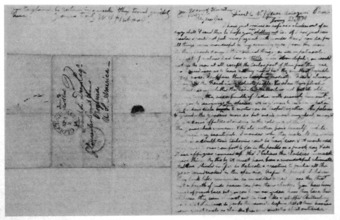
Letter written by W. J. Hubard to Josiah L. Deans from Paris, 21 January 1838.
Valentine Museum, Richmond, Virginia
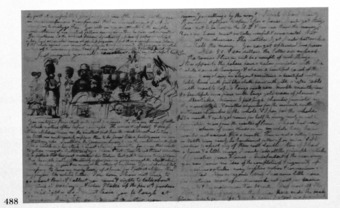
The central part of the letter illustrated in 487.
Valentine Museum, Richmond, Virginia
